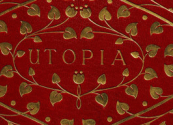A Secondary Article about Cavendish and Romance
by Elissa Myers
Turner, James Grantham. “Romance and the Novel in Restoration England.” Review of English Studies 63.258 (2012): 58-85. Oxford Journals Online. Web.
While Turner only mentions Margaret Cavendish in passing in this article, it is useful for contextualizing her utopian narrative, The Blazing World within the context of other developments in fictional narrative of the Restoration. Turner’s argument relates to the developing distinction between “old” romances, involving giants, dragons, and other unlikely beings and occurrences, and “new” romances, in which authors made vehement attempts at verisimilitude, often purporting to relate true stories from history which were embellished with conversations between and interior thoughts of characters.
Though today, we often think of such devices as realistic, Turner states that it was just this quality of realism that made “new” romance a contested genre. Many thought such devices to be embellishments which unnecessarily muddled fact and fiction in readers’ minds. Turner notes that Cavendish herself felt ambivalently about the genre, expressing an aversion to “telling Romansical falsehoods for historical truths,” while overtly calling Blazing World “romancical” (Cavendish qtd. Turner 71).
However, Cavendish’s work also resists categorization under Turner’s definitions of romance. Unlike either old or new romances, Cavendish’s romance attempts to make the impossible appear realistic. Examples of this tendency are when she makes scientific justifications for the fantastic things in her blazing world, such as how two worlds could exist at the same geographical location though people can only see one sun, and when she describes at length the kinds of precious stones available in this world, etc.
The question for me was: Why would Cavendish go to such trouble to make these unrealistic things seem realistic? What does this say about her purpose for writing The Blazing World? Luckily, we can also turn to Cavendish’s own words, as she discusses her purpose in the preface to the work. Cavendish acknowledges that her work joins two genres, the philosophical and the “romancical,” and that this is an unorthodox choice (Cavendish 124). In her preface, she states that her purpose in making this choice is twofold: to “divert my studious thoughts,” and to “delight the reader with variety” (Cavendish 124). Though divert may mean, in one sense, to amuse, according to the OED, it can also mean to “turn aside (a thing, as a stream, etc.) from its (proper) direction. Thus, Cavendish’s Blazing World could also be read as an attempt to dazzle the reader with its brightness, to alienate one from one’s serious thoughts on philosophy and science by presenting another fully formed, thought out world, which though it is ostensibly merely a fanciful world to be enjoyed, actually presents serious philosophical arguments about the best ways to engage in scientific inquiry and to structure a state. Indeed, in the Empress’s words, the Blazing World is a “romancical Cabbala, wherein you can use metaphors, allegories, similitudes, etc. and interpret them as you please” (Cavendish 183).
Though Turner does not struggle with the ways in which Cavendish’s Blazing World departs from the romance genre, his delimitation of the genre’s boundaries and discussion of her ambivalence about the genre helped me begin to think about how her work troubles generic boundaries and why she might have been interested in doing so. I hope others find these questions interesting as well, and that my review of the article and thoughts about it might spark discussion about them!


